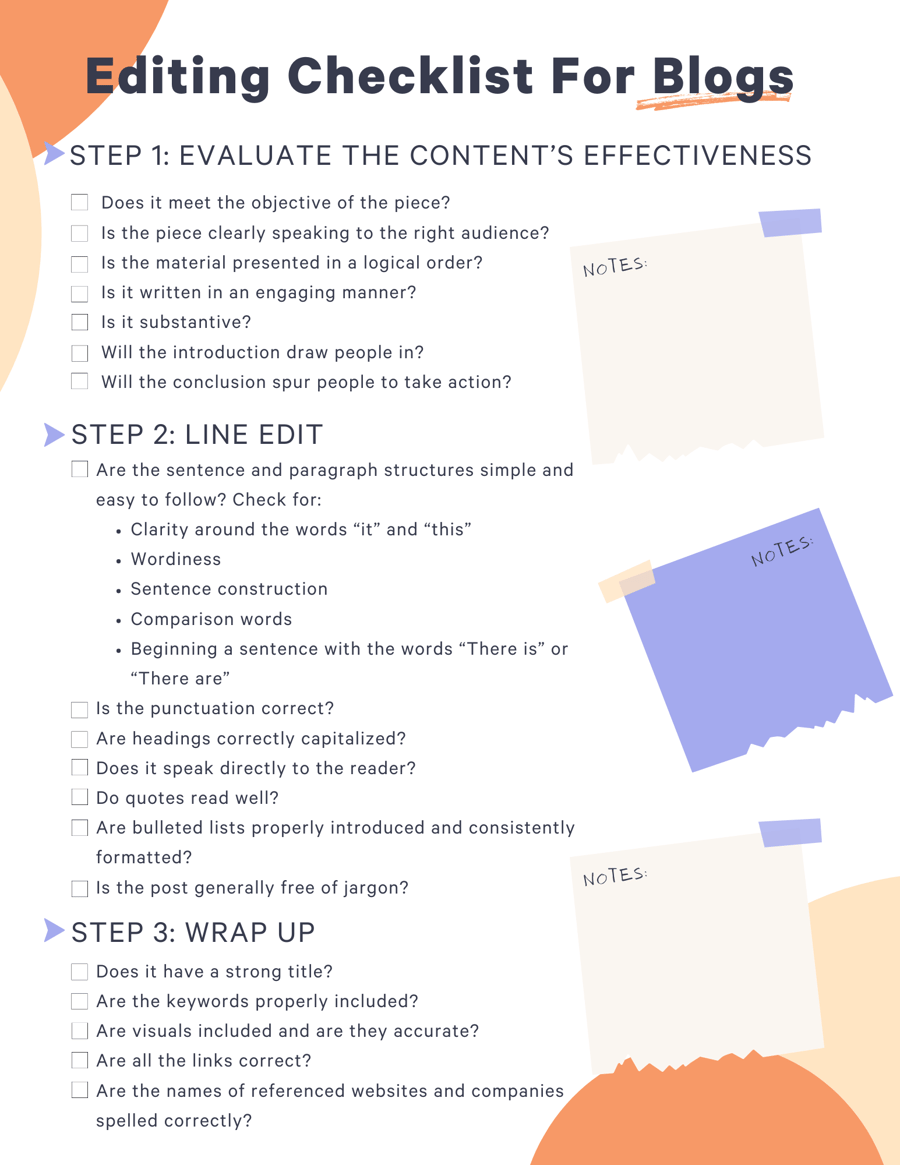Content Editing For Business: A Step-By-Step Guide



If you’ve landed here, hopefully you’ve got an amazing blog article nearly ready to publish, virtually lighting your screen on fire. 🔥You’ve put in a ton of effort interviewing an SME, crafting 1,200 words of interesting prose, and even giving it a quick run through Grammarly to make sure it’s mistake-free. You can’t WAIT to hit the “publish” button and release it into the world.
Hold the phone, friend. I hate to break it to you but what you just wrote was called a first draft in the writing world. (Well, since we’re writing a blog and not a book, we’ll maybe call it a “nearly-there” draft, because no one has the time to rewrite blog posts multiple times over—heck, we’re not writing a manual for brain surgery.) Whatever you call it, your first writing of a blog post CANNOT have its big reveal without undergoing some degree of editing. The reason:
A blog post will fail to do its job if it isn’t written clearly, structured logically, and presented professionally—attributes that can only be evaluated and addressed during the editing process.
Not only that, but company leaders want to publish blogs they can be proud of, and editing plays an important role in making that happen. It’s why our prospects are always pleasantly surprised to learn that Nectafy has built content editing into our Growth Content process. We have an editor review every client post—and our writers revise accordingly—before passing it on to a client. Most writing agencies don’t include editing as part of the writing process, which means clients themselves end up working as editors—a job they shouldn’t have to do. (Nor do they have the time to do it!)
So if you’re publishing blog posts regularly without a formal content editing process in place, now’s the time to change all that.
Want to see samples of the types of lead-generating content you could get working with Nectafy? Download our Growth Content Portfolio and take a peek!
Content Editing For Business: How To Edit A Blog Post
Before you plug your ears, tune out the rest of this advice, and hit publish on your post anyway, keep in mind that editing doesn’t necessarily result in hours of additional writing work. Your post may be in fairly good shape already, in which case it may just require some polishing. While it’s best if that determination is made by an objective party—an editor who isn’t also the writer—self-editing is possible and encouraged (even if you do have someone fulfilling the editor role).
Whether you’re self-editing or turning your piece over to a professional editor, the following information will be helpful in directing your attention to the most crucial elements of blog editing.
Step 1: Evaluate The Content’s Effectiveness
An editor’s first review of a blog post should begin with a high-level evaluation of the piece. To do this, ask:
- Does it meet the objective of the piece? Think about why you’re publishing it. What idea or concept do you want to get across to readers? Do all the ideas in the piece support that goal? Are there extraneous ideas that cloud the objective and should be removed?
- Is the piece clearly speaking to the right audience? If the audience for the post is unclear—or the content seems to be directed to a different audience than the one you’re really trying to reach—the post won’t have the impact you expect. Identify your reader (either directly or indirectly) in the introduction.
- Is the material presented in a logical order? Generally, this means you’ve started by identifying a problem or challenge for the audience, clarified how this post will help to address it, and organized the presentation of your material in a logical way. Check that each paragraph naturally leads into the next, and that if there is “sidebar” material (material related to but not part of the central discussion), is it clearly identified as such.
- Is it written in an engaging manner? Writing that is dry or too technical can turn an audience off—it’s easier to look elsewhere for answers than to slog through difficult prose. Articles should be written in a way that piques interest. To do that, make sure the material aligns with your readers’ point of view (rather than your own perspective as a business).
- Is it substantive? If the article appears to be just a generic regurgitation of information from other sites or it covers the subject in a shallow manner, readers probably won’t stick around until the end. However, if the article is heavily based on original SME input, this shouldn’t be a problem. SMEs usually have unique perspectives on their assigned topics, and their insights lend authenticity to a post.
- Will the introduction draw people in? Personally I’m a stickler for compelling intros. While it’s easy to fall back on a generic introduction that simply introduces the SME’s take and then steps aside, I prefer to see an intro that does the hard work of drawing people in. It might offer a compelling reason why the article will be helpful, shock them with a wild statistic, tell an interesting story, ask an intriguing question—or do any number of other things.
- Will the conclusion spur people to take action? While most blog posts are not intended to be sales tools (unless they are BOF landing page posts), there’s no reason not to take a few sentences at the end to connect the topic at hand with a possible solution your company has to offer. Just be sure that whatever it is you’re plugging—maybe it’s a white paper download, a free trial, or an upcoming webinar—naturally relates to the post and is offered in a helpful (not salesy) way.
“An editor should never allow something to get into print that he doesn’t understand. If he doesn’t understand it, at least one other person won’t, and that’s one too many.”
—William Zinsser, “On Writing Well”
An editor should carefully consider the piece from all these vantage points, and make suggestions, if necessary, on how the writer can improve in these areas. These types of edits tend to require the most effort on the part of the writer, but it’s crucial for blog posts to pass these checkpoints in order for the post to produce results.
How much could your company grow with growth content?
Calculate your expected growth in organic visits based on the average Nectafy client.
Get all these numbers in your inbox.
Step 2: Line Edit
In contrast to the first step of content editing, line editing focuses more on the words and sentences of the post rather than on the overall structure of the piece. In traditional publishing, line editing is sometimes done separately from structural/content editing, but in the case of a blog post, it happens simultaneously—UNLESS the post required so much rewriting that doing a line edit would be useless. In that case, the blog post should be rewritten first, then passed back to the editor for a second round of editing.
During a line edit, the editor combs through each sentence with a fine-toothed comb to assess the following:
- Are the sentence and paragraph structures simple and easy to follow? Each sentence should be clear and direct, and lead into the next one; the same is true for paragraphs. Some specific things to watch out for:
- The words “it” and “this”—Is it completely clear to the reader what these words refer to?
- Wordiness—Eliminate words and tighten where possible. Avoid phrases like “it’s important to” and “in order to” because they are usually unnecessary and clutter up the copy.
- Sentence construction—Avoid ending sentences or phrases with verbs, i.e. “It can be difficult to decide what the next move is.” (Change it to “It can be difficult to decide the next move.”) Also avoid ending sentences with words like “for”, “at”, “by,” and other similar types of endings. Example: “We ask this question to get feedback on how well our prototype solves for the specific problem we designed for.” “We ask this question to get feedback on how well our prototype solves for the intended problem.”
- Comparison words—When using words that imply a comparison (like “deeper” or “broader” or “more substantive”), the two things being compared must be evident. For example, “This strategy gives you deeper insight into your company”—deeper than what?
- Beginning a sentence with the words “There is” or “There are”—Sentences that start this way are weakly constructed. Example: “There are several reasons why outsourcing HR tasks is beneficial”; “Outsourcing HR tasks is beneficial for lots of reasons, including…”
- Is the punctuation correct? Aside from the usual assessment of correct punctuation, pay close attention to punctuation in bulleted lists. If bulleted items are complete sentences they should have periods; if not, no periods.
- Are headings correctly capitalized? This depends on your company’s personal style. At Nectafy, we use title case capitalization across the board unless the heading is a sentence or question, where sentence case applies.
- Does it speak directly to the reader? Does it address the reader directly if appropriate? Writing “you” or “your” rather than “a startup founder” or “an organization” gives the impression you’re speaking directly to the reader and gives the piece more immediacy.
- Do quotes read well? As long as you’re not changing the person’s intended meaning, I’d advise making any necessary small edits to ensure quotes read smoothly. (Personally, I think the quoted person would prefer the change if it will make them look better.)
- Are bulleted lists properly introduced and consistently formatted? Each bullet point in a bulleted list should be formatted consistently with the rest, in terms of both punctuation and phrasing. Do they all use colons or em dashes? Are they all questions or statements? Are they all complete sentences or not? Do they all begin with the same part of speech? Also, check the line leading into a bulleted list to make sure it introduces the items in the correct way. For example: “Our strategy includes: building a website, doing focus groups, hiring specialists, etc.” as opposed to “To launch a new product, we do the following: building a website, doing focus groups, hiring specialists, etc.”
- Is the post free of jargon? Avoid using specialized business terminology in your posts because it is meaningless to readers, who may not be familiar with those terms. Writers sometimes fall back on jargon—words like “holistic” “granularity” and “actionable,” for example—as a way of making their sentences seem more authoritative, but these words just obscure the writer’s real meaning. (Sometimes, when pressed to rewrite a jargon-filled sentence, writers realize they DON’T actually know what a particular sentence means!)
“Writing is often the process by which you realize that you do not understand what you are talking about.”
—Shane Parrish
Step 3: Wrap Up
The last stage of the content editing process consists of addressing some final details that will make the piece complete. As the editor you should ask:
- Are the keywords properly included? As we’ve stated in other posts, your blog articles should target certain keywords your audience uses to search. (Here’s more on where and how to place keywords most effectively.) Make sure the assigned keywords are present within the article and are used naturally.
- Does it have a strong title? The title could make the difference between whether someone clicks on the post or not, so titles are important. Consider these two titles: “3 Things To Consider Before Buying Automation Software” and “Will Automation Software Actually Reduce Your Data Entry Errors?” Personally, I’d be more intrigued by the second one, which tells me exactly what the blog post will cover and would seem to address my concern directly.
- Are visuals included and accurate? Visuals are a necessity for blog posts. They make a post more memorable, add variety to the page, and help draw readers’ attention to important points. If the writer hasn’t already included visuals or noted places where they could be added, the editor should do so now.
- Are all the links correct? Check for any broken links and correct them. Also, make sure the linked articles or sites are relevant to the topic at hand, and that they are what the reader would expect to find should they click on them. (If the writer has hyperlinked the phrase “strategy templates,” the reader would expect that the link would bring them to downloadable templates or something similar, rather than an article on how to develop a strategy, for instance.)
- Are the names of referenced websites and companies spelled correctly? Spelling company or site names wrong is unprofessional, especially if they are associated with an SME or are integral to the post in some way. But company names can be tricky—sometimes two words are used as one or the capitalization is nontraditional. To make sure your article includes the correct site and company names, refer to the copyright notice at the bottom of a site for the correct spelling.

Click here to download and print this blog post editing checklist!
No time for content editing? Let Nectafy help!
If you’re struggling to find time for blog editing, consider the quality of your content overall; is it truly doing the work of bringing in leads for your business? If you want to explore the kind of content Nectafy could write and edit—and plan in accordance with your company’s goals—download our Growth Content Portfolio. It includes samples of some of the lead-generating content we’ve created that has helped other clients to achieve amazing results. On average, Nectafy clients that have 1,000 organic visits per month at the start of our partnership increase that number to 13,609 after just one year (13.6x). That means more prospects for your business, more time for you, and better content to boot.

